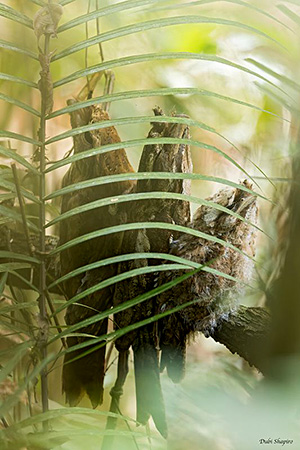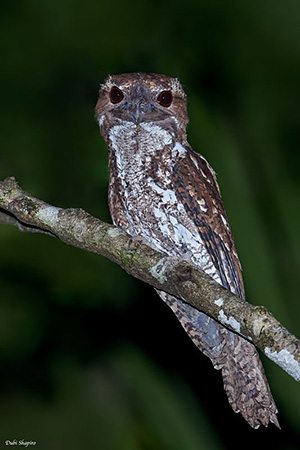
Fr: Podarge ocellé
Ang: Marbled Frogmouth
All: Marmorschwalm
Esp: Podargo Ocelado
Ita: Bocca di rana marmorizzato
Nd: Gemarmerde Uilnachtzwaluw
Sd: marmorgrodmun
Photographers:
Callie de Wet
GALLERY
Dubi Shapiro
Dubi Shapiro Photo Galleries
Text by Nicole Bouglouan
Sources:
HANDBOOK OF THE BIRDS OF THE WORLD Vol 5 by Josep del Hoyo-Andrew Elliott-Jordi Sargatal - Lynx Edicions - ISBN: 8487334253
NIGHTJARS - A Guide to Nightjars and Related Nightbirds – Nigel Cleere and Dave Nurney - Yale University Press - First Edition (August 11, 1998) - ISBN 10: 0300074573 / ISBN 13: 9780300074574
Nightjars and Their Allies: The Caprimulgiformes De D.T. Holyoak – Editeur : OUP Oxford, 2001 – ISBN: 0198549873, 9780198549871 – 773 pages
Rarely seen marbled frogmouth nest snapped after 'absolutely crazy' three-week effort
Mary Cairncross - Marbled Frogmouth
Podargus ocellatus (PODARGIDAE) Marbled Frogmouth
CREAGUS@Monterey Bay (Don Roberson)
Fatbirder - The World’s Richest Information Resource about Birds for Birders
Marbled Frogmouth & Tawny Frogmouth
MARBLED FROGMOUTH IN THE CONONDALE RANGE, SOUTH-EASTERN QUEENSLAND
Marbled frogmouth facts for kids
Wikipedia, the free encyclopaedia
Marbled Frogmouth
Podargus ocellatus
Podargiformes Order – Podargidae Family
INTRODUCTION:
The Marbled Frogmouth is the third member of genus Podargus with the Tawny Frogmouth and the Papuan Frogmouth, all members of the subfamily Podarginae from Australasia. Five subspecies share the large range.
The Marbled Frogmouth is found in the Aru Islands, New Guinea and Queensland, where it lives in humid forests, also at forest edges and tall secondary forest. It is nocturnal when feeding on large insects taken on the ground after sallying out from perches.
This species builds a small platform of twigs and other plant material. It is placed high in tree, and one or occasionally two eggs are laid. Both parents share the nesting duties.
The name “frogmouth” refers to the large, flattened, hooked bill, similar to a frog’s mouth when it is open.
The Marbled Frogmouth has large range, but it is threatened by habitat destruction for agriculture expansion, grazing and timber production. However, the species is not considered globally threatened at the moment.
DESCRIPTION OF THE BIRD:
Biometrics:
Length: 37-48 cm
Wingspan: 62-75 cm
Weight: M: 137-156 g – F: 132-141 g
The plumage of the Marbled Frogmouth varies from grey to brown or rufous-brown. It is finely streaked and mottled with black, and spotted or mottled with white, especially on the underparts. The tail is long and graduated. The wings are rounded, with longer 5th, 6th and 7th primaries.

On the head, there is a pale supercilium, a dark stripe from the bill’s base, and a prominent tuft of feathers and bristles protecting and hiding the nostrils forming narrow slits near the bill’s base.
The large bill is brownish-horn. The tongue of the members of genus Podargus has a long, transparent, paper-like tip.
The eyes are usually orange, ranging from yellow to brown, red, reddish-brown or orange-red.
The legs are very short, and both legs and feet are rather weak. They are flesh or pinkish-brown.
The female is generally darker than male, but they are often fairly similar.
The female of race P.o. plumiferus shows more uniform pattern and buffer coloration on the underparts than the male.
The juvenile is mainly rufous-brown finely barred white and blackish on the upperparts. The underparts are whitish and finely barred brown.
SUBSPECIES AND RANGE:
The Marbled Frogmouth has five subspecies. They differ mostly in size and details of plumage colour.
P.o. ocellatus (described above) is found in New Guinea, W Papua Islands, Aru Islands and islands in Geelvink Bay.
P.o. intermedius occurs in Trobriand Islands and D’Entrecasteaux Archipelago.
This race resembles nominate but it is larger (40-42,5 cm). The male may be paler than nominate, with greyer upperparts and whiter underparts.
P.o. meeki is found on Tagula Island (Louisiade Archipelago).
This one is intermediate in size between the two previous races. The female is brownish and never tinged rufous.
P.o. marmoratus is found in NE Australia (Cape York Peninsula).
It is similar to nominate but with longer tail. The facial bristles are also longer and the eyes are yellower. Some males may have more whitish spotting on the underparts.
P.o. plumiferus (Plumed Frogmouth) occurs in coastal E Australia (SE Queensland to NE New South Wales).
This race is the largest with a length of 45-48 cm. It is sometimes considered as a colour variation of the nominate race of the Tawny Frogmouth, while others consider it as a full species.
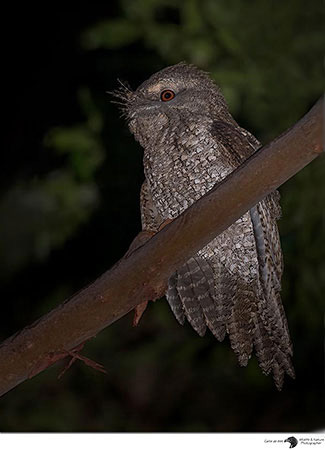
HABITAT:
The Marbled Frogmouth frequents mainly dense, closed lowland rainforest. However, it can be found in isolated areas within this forest, also at forest edges and in tall secondary forests.
In Papua New Guinea, it frequents eucalypt savanna and occurs up to 2,200 metres of elevation, whereas in N Australia, it can be seen in coastal and riverine vine forests, up to 1,600 metres. In E Australia, it is found in tall/medium subtropical rainforest with thick canopy cover. It generally favours areas with steep gullies and running water.
CALLS AND SONGS: SOUNDS BY XENO-CANTO
The frogmouths are usually highly vocal, and sing or call to advertise and defend the territory.
The Marbled Frogmouth male gives series of up to nine mournful notes or a series of liquid “koor-loo, koo-loo, koo-look” or “whoor-loop” notes, occasionally rising slightly in pitch. This song or call is often given in short bursts, but it may continue for long periods during the breeding season.
The song of the female is similar but harsher.
During the breeding season, both adults give an accelerating series of “gobbling” notes rising or descending in pitch. This sound is used as a warning of territory or nest-site occupancy. It may sometimes end in bill-snaps.
Other calls like a liquid “woo-woo-woo-woo-wooa” (male) and “wa-wa-wa-wa-wa” (female) also end in bill-snapping.
We can also hear a monotonous trill, a loud, high-pitched trill, or “brrrr” and short barking “chuck” notes.
At nest, soft squeaking, hissing and rasping sounds are heard when male and female feed each other. The adult gives a low-pitched growl when it is with the chick, and the fledgling gives a monotonous series of “awhoo”, “kooo” or “koo-looo” notes. The alarm call is a hissing sound.
The Marbled Frogmouth sings from perches, a branch in tree or low hanging vines. It is mainly heard at dusk and dawn, but during the breeding season, it often sings throughout the night.
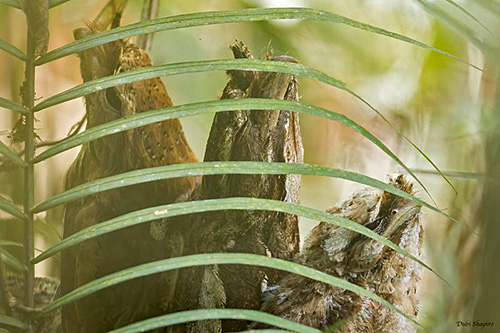
BEHAVIOUR IN THE WILD:
The Marbled Frogmouth feeds mainly on large, nocturnal insects such as beetles and grasshoppers, but stoneflies, cockroaches, earwigs, Orthoptera, moths, moth larvae, spiders, bugs and occasionally frogs are also part of its diet.
It hunts at night from larges perches such as stumps or low branches, by sallying out to catch the prey from the ground or from foliage. The prey is taken with the bill after a diving glide from the mid-canopy.
Large prey and hard food items are carried back to the perch where they are vigorously battered before being eaten.
During the day, the Marbled Frogmouth rests in trees. It sleeps on a branch with the bill pointing upwards, very similar to a tree branch.
This species must adopt panting as a cooling mechanism during periods of hyperthermia caused by the hot and humid weather conditions of its tropical habitat.
It roosts in the canopy, and its cryptic plumage makes it hard to find. It usually roosts singly, but also occasionally in pairs (shoulder-to-shoulder) or in small family groups. The chick roosts very close or between its parents.
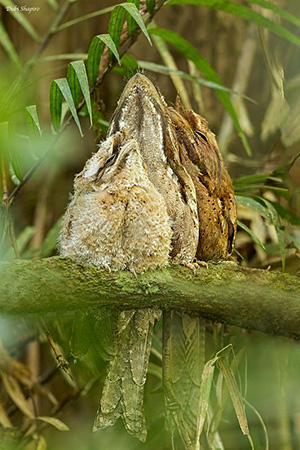
When threatened, it assumes an alarm-posture. The feathers are compressed, neck and head are stretched while head and bill are pointing upwards. It also may spread its wings in defence display. It can also be seen roosting close to a tree trunk where the cryptic plumage makes it almost invisible.
The Marbled Frogmouth is active throughout the night during the breeding season. The species is territorial all year round. The adults regularly call at night from the nest-site. Both adults share the nesting duties and build the nest together.
All subspecies are sedentary and remain in territories year-round.
The flight of the frogmouths is weak. The wings are rounded and adapted to their feeding behaviour based on short, sallying flights from perches. The frogmouths are less aerial than most of their relatives in the order Caprimulgiformes.
REPRODUCTION OF THIS SPECIES:
The breeding season takes place from August to December throughout the range. The Marbled Frogmouth is territorial all year round.
The nest is built by both adults. They collect material by snapping off twigs and sticks while diving down, but they also break off sticks just above the nest-site.
The nest is a small, shallow platform of about 8-20 cm in diameter and 2-4 cm deep. This structure is made of twigs, sticks, vine tendrils, grasses, lichens and moss. It is placed between 3 and 15 metres above the ground, occasionally higher, often on a flat tree-fork or in the crown of epiphytes. It may be used in several following years.
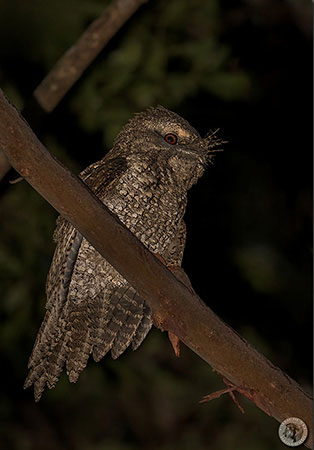
The female lays a single dull white egg, occasionally two, in a shallow depression in the middle of the platform. The incubation lasts about 31 days (race P.o. plumiferus), shared by both parents, the male during the day while the female roosts in the vicinity of the nest-site. The incubating bird is visited and fed every 15 minutes during the night.
At hatching, the chick has white down first. It is semi-altricial and nidicolous. It fledges a month after hatching.
It is reported that only single young fledge from nests in Cape York Peninsula, even if two eggs are laid.
PROTECTION / THREATS / STATUS:
The Marbled Frogmouth is threatened by habitat destruction caused by logging and forest clearance. The species is living in patches of subtropical forest.
The race P.o. plumiferus has declined, following habitat destruction caused by logging, agriculture expansion, grazing and timber production. It is now a rare bird.
The Marbled Frogmouth has large range. The size of the population is unknown but it is suspected to be declining and the species is rare.
However, the Marbled Frogmouth is not considered globally threatened, and the species is currently evaluated as Least Concern. But more information is required.
